2018 HONDA CLARITY FUEL CELL cooling
[x] Cancel search: coolingPage 13 of 551
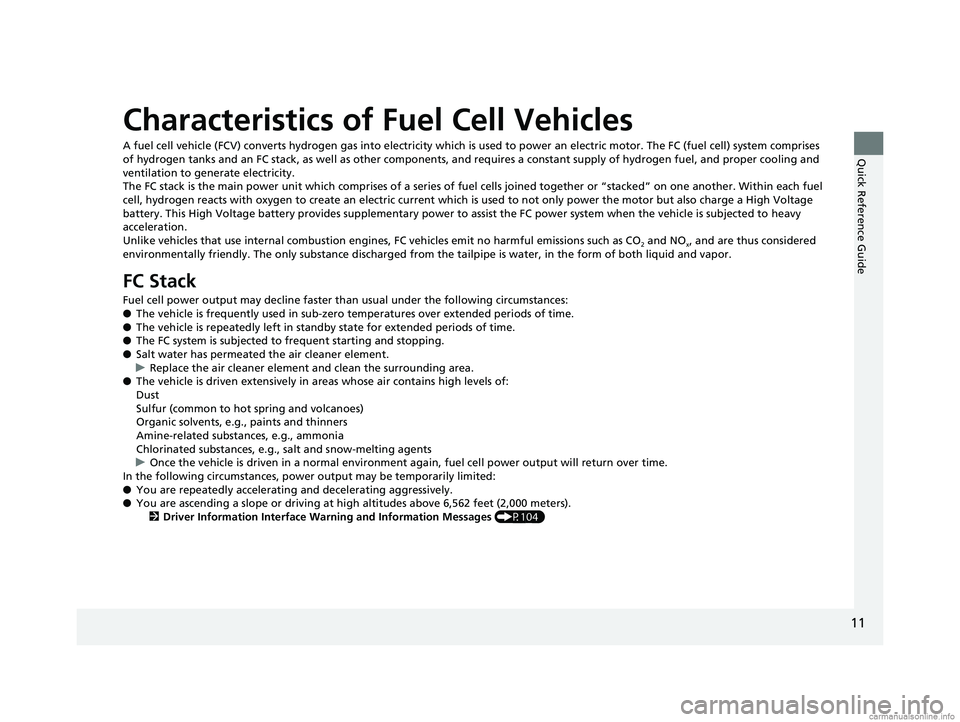
11
Quick Reference Guide
Characteristics of Fuel Cell Vehicles
A fuel cell vehicle (FCV) converts hydrogen gas into electricity which is used to power an electric motor. The FC (fuel cell) system comprises
of hydrogen tanks and an FC stack, as well as other components, and requires a constant supply of hydrogen fuel, and proper cooling and
ventilation to generate electricity.
The FC stack is the main power unit which comprises of a series of fuel cells joined together or “stacked” on one another. With in each fuel
cell, hydrogen reacts with oxygen to create an electric current whic h is used to not only power the motor but also charge a High Voltage
battery. This High Voltage battery provides supplementary power to assist the FC power system when the vehicle is subjected to heavy
acceleration.
Unlike vehicles that use internal combustion engines, FC vehicles emit no harmful emissions such as CO
2 and NOx, and are thus considered
environmentally friendly. The only substa nce discharged from the tailpipe is water, in the form of both liquid and vapor.
FC Stack
Fuel cell power output may decline faster th an usual under the following circumstances:
● The vehicle is frequently used in sub-zero temperatures over extended periods of time.
● The vehicle is repeatedly left in stand by state for extended periods of time.
● The FC system is subjected to frequent starting and stopping.
● Salt water has permeated the air cleaner element.
u Replace the air cleaner element and clean the surrounding area.
● The vehicle is driven extensively in areas whose air contains high levels of:
Dust
Sulfur (common to hot spring and volcanoes)
Organic solvents, e.g., paints and thinners
Amine-related substa nces, e.g., ammonia
Chlorinated substances, e.g., salt and snow-melting agents
u Once the vehicle is driven in a normal environment again, fuel cell power output will return over time.
In the following circumstances, power output may be temporarily limited:
● You are repeatedly accelerating and decelerating aggressively.
● You are ascending a slope or driving at high altitudes above 6,562 feet (2,000 meters).
2 Driver Information Interface Wa rning and Information Messages (P104)
18 CLARITY FUEL CELL PPO-31TRT6100.book 11 ページ 2017年11月21日 火曜日 午後3時3分
Page 21 of 551
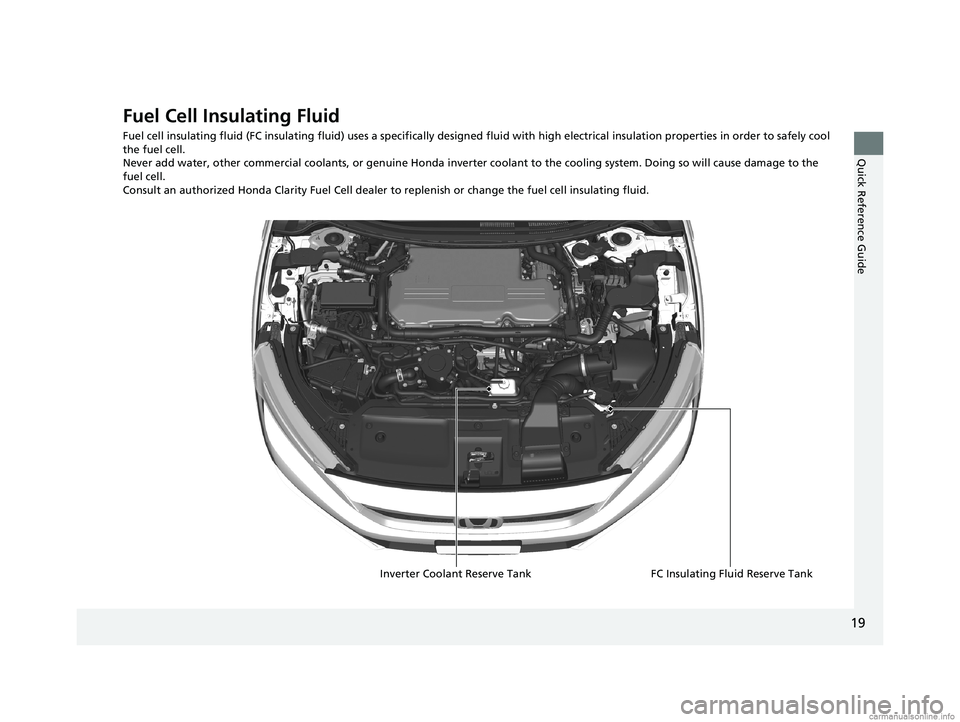
19
Quick Reference Guide
Fuel Cell Insulating Fluid
Fuel cell insulating fluid (FC insulating fluid) uses a specifically designed fluid with high electrical insulation properties in order to safely cool
the fuel cell.
Never add water, other commercial coolants, or genuine Honda inverter coolant to the cooling system. Doing so will cause damage to the
fuel cell.
Consult an authorized Honda Clarity Fuel Cell dealer to replenish or change the fuel cell insulating fluid.
FC Insulating Fluid Reserve Tank
Inverter Coolant Reserve Tank
18 CLARITY FUEL CELL PPO-31TRT6100.book 19 ページ 2017年11月21日 火曜日 午後3時3分
Page 461 of 551
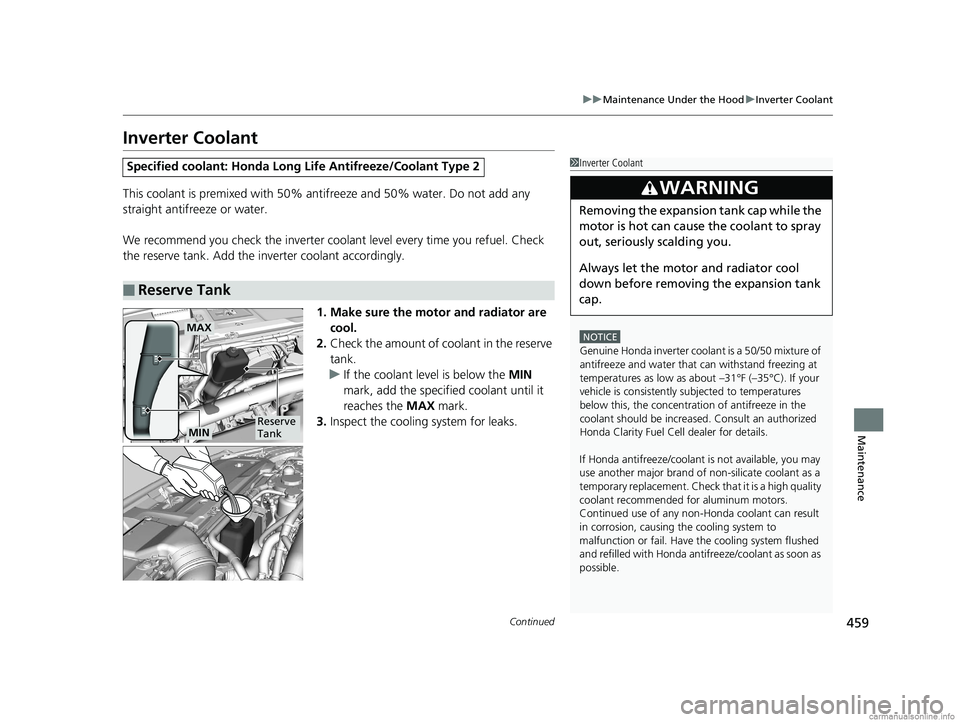
459
uuMaintenance Under the Hood uInverter Coolant
Continued
Maintenance
Inverter Coolant
This coolant is premixed with 50% an tifreeze and 50% water. Do not add any
straight antifreeze or water.
We recommend you check the inverter coolant level every time you refuel. Check
the reserve tank. Add the in verter coolant accordingly.
1. Make sure the motor and radiator are cool.
2. Check the amount of coolant in the reserve
tank.
u If the coolant level is below the MIN
mark, add the specified coolant until it
reaches the MAX mark.
3. Inspect the cooling system for leaks.
Specified coolant: Ho nda Long Life Antifreeze/Coolant Type 2
■Reserve Tank
1Inverter Coolant
NOTICE
Genuine Honda inverter cool ant is a 50/50 mixture of
antifreeze and water that can withstand freezing at
temperatures as low as a bout –31°F (–35°C). If your
vehicle is consistently subjected to temperatures
below this, the concentration of antifreeze in the
coolant should be increased. Consult an authorized
Honda Clarity Fuel Ce ll dealer for details.
If Honda antifreeze /coolant is not available, you may
use another major brand of non-silicate coolant as a
temporary replacement. Check that it is a high quality
coolant recommended fo r aluminum motors.
Continued use of any non-Honda coolant can result
in corrosion, causing the cooling system to
malfunction or fail. Have the cooling system flushed
and refilled with Honda antifreeze/coolant as soon as
possible.
3WARNING
Removing the expansion tank cap while the
motor is hot can cause the coolant to spray
out, seriously scalding you.
Always let the motor and radiator cool
down before removing the expansion tank
cap.
MAX
Reserve
TankMIN
18 CLARITY FUEL CELL PPO-31TRT6100.book 459 ページ 2017年11月21日 火曜日 午後3時3分
Page 462 of 551
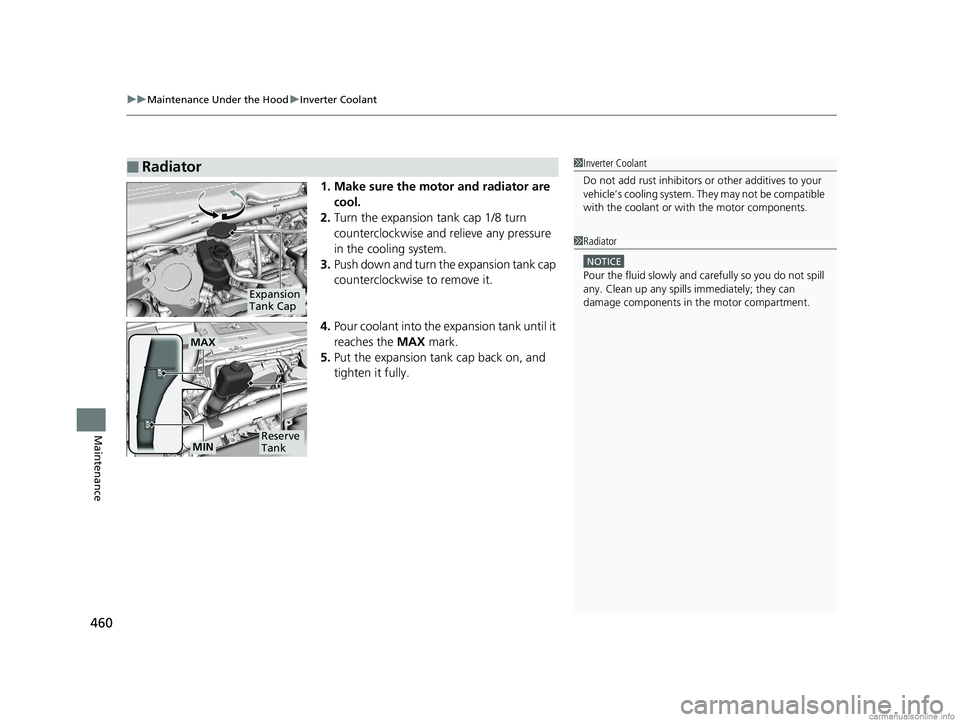
uuMaintenance Under the Hood uInverter Coolant
460
Maintenance
1. Make sure the motor and radiator are
cool.
2. Turn the expansion tank cap 1/8 turn
counterclockwise and relieve any pressure
in the cooling system.
3. Push down and turn the expansion tank cap
counterclockwise to remove it.
4. Pour coolant into the expansion tank until it
reaches the MAX mark.
5. Put the expansion tank cap back on, and
tighten it fully.
■Radiator 1Inverter Coolant
Do not add rust inhibitors or other additives to your
vehicle’s cooling system. They may not be compatible
with the coolant or with the motor components.
1 Radiator
NOTICE
Pour the fluid slowly and ca refully so you do not spill
any. Clean up any spills immediately; they can
damage components in the motor compartment.
Expansion
Tank Cap
MAX
Reserve
TankMIN
18 CLARITY FUEL CELL PPO-31TRT6100.book 460 ページ 2017年11月21日 火曜日 午後3時3分
Page 482 of 551
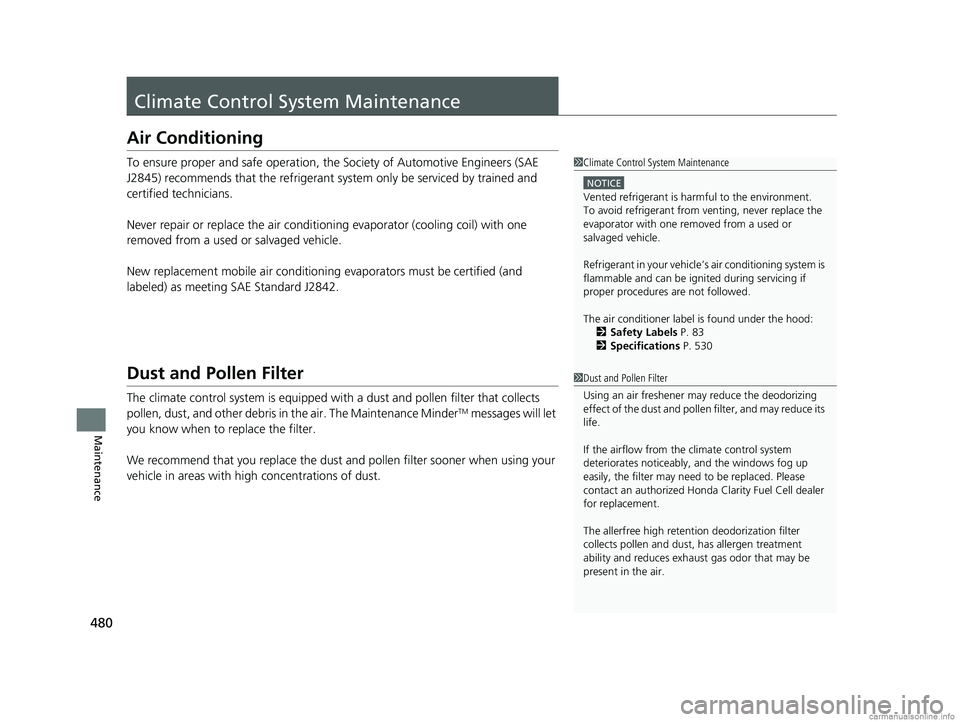
480
Maintenance
Climate Control System Maintenance
Air Conditioning
To ensure proper and safe operation, th e Society of Automotive Engineers (SAE
J2845) recommends that the refrigerant system only be serviced by trained and
certified technicians.
Never repair or replace the air conditioning evaporator (cooling coil) with one
removed from a used or salvaged vehicle.
New replacement mobile air conditioning evaporators must be certified (and
labeled) as meeting SAE Standard J2842.
Dust and Pollen Filter
The climate control system is equipped with a dust and pollen filter that collects
pollen, dust, and other debris in the air. The Maintenance MinderTM messages will let
you know when to replace the filter.
We recommend that you replace the dust a nd pollen filter sooner when using your
vehicle in areas with high concentrations of dust.
1 Climate Control System Maintenance
NOTICE
Vented refrigerant is harmful to the environment.
To avoid refrigerant from venting, never replace the
evaporator with one re moved from a used or
salvaged vehicle.
Refrigerant in your vehicle’s air conditioning system is
flammable and can be igni ted during servicing if
proper procedures are not followed.
The air conditioner labe l is found under the hood:
2 Safety Labels P. 83
2 Specifications P. 530
1Dust and Pollen Filter
Using an air freshener may reduce the deodorizing
effect of the dust and polle n filter, and may reduce its
life.
If the airflow from the climate control system
deteriorates noticeably, and the windows fog up
easily, the filter may need to be replaced. Please
contact an authorized Honda Clarity Fuel Cell dealer
for replacement.
The allerfree hi gh retention deodor ization filter
collects pollen and dust, has allergen treatment
ability and reduces exhaus t gas odor that may be
present in the air.
18 CLARITY FUEL CELL PPO-31TRT6100.book 480 ページ 2017年11月21日 火曜日 午後3時3分
Page 512 of 551
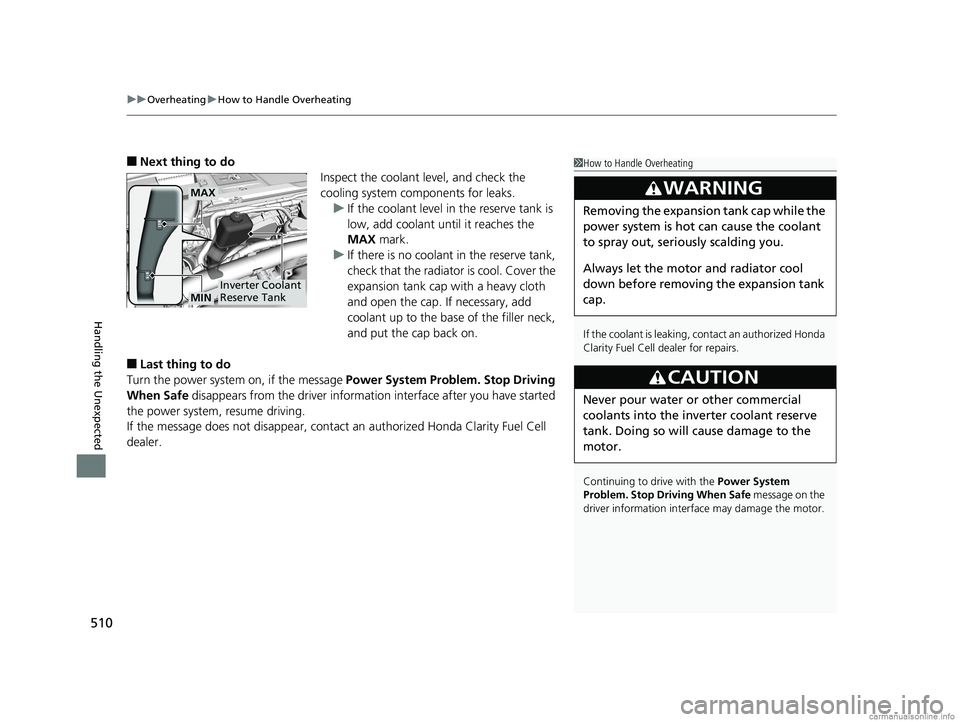
uuOverheating uHow to Handle Overheating
510
Handling the Unexpected
■Next thing to do
Inspect the coolant level, and check the
cooling system components for leaks.u If the coolant level in the reserve tank is
low, add coolant until it reaches the
MAX mark.
u If there is no coolan t in the reserve tank,
check that the radiator is cool. Cover the
expansion tank cap with a heavy cloth
and open the cap. If necessary, add
coolant up to the base of the filler neck,
and put the cap back on.
■Last thing to do
Turn the power system on, if the message Power System Problem. Stop Driving
When Safe disappears from the driver informatio n interface after you have started
the power system, resume driving.
If the message does not disappear, contact an authorized Honda Clarity Fuel Cell
dealer.
1 How to Handle Overheating
If the coolant is leaking, contact an authorized Honda
Clarity Fuel Cell dealer for repairs.
Continuing to drive with the Power System
Problem. Stop Driving When Safe message on the
driver information interface may damage the motor.
3WARNING
Removing the expansion tank cap while the
power system is hot can cause the coolant
to spray out, seri ously scalding you.
Always let the motor and radiator cool
down before removing the expansion tank
cap.
3CAUTION
Never pour water or other commercial
coolants into the inve rter coolant reserve
tank. Doing so will cause damage to the
motor.
MAX
Inverter Coolant
Reserve TankMIN
18 CLARITY FUEL CELL PPO-31TRT6100.book 510 ページ 2017年11月21日 火曜日 午後3時3分